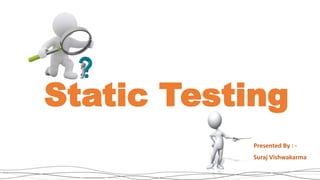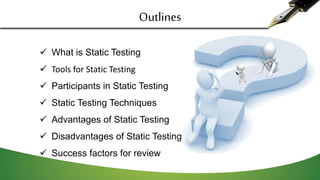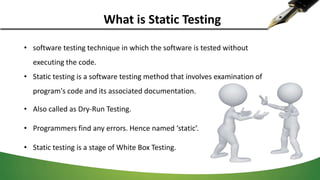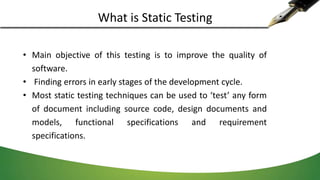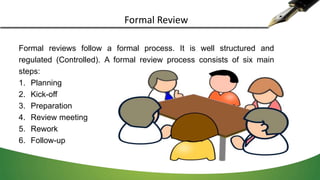Static Testing
- 1. Static Testing Presented By : - Suraj Vishwakarma
- 2. Outlines ïž What is Static Testing ïž Tools for Static Testing ïž Participants in Static Testing ïž Static Testing Techniques ïž Advantages of Static Testing ïž Disadvantages of Static Testing ïž Success factors for review
- 3. âĒ software testing technique in which the software is tested without executing the code. âĒ Static testing is a software testing method that involves examination of program's code and its associated documentation. âĒ Also called as Dry-Run Testing. âĒ Programmers find any errors. Hence named âstaticâ. âĒ Static testing is a stage of White Box Testing. What is Static Testing
- 4. What is Static Testing âĒ Main objective of this testing is to improve the quality of software. âĒ Finding errors in early stages of the development cycle. âĒ Most static testing techniques can be used to âtestâ any form of document including source code, design documents and models, functional specifications and requirement specifications.
- 5. What is Static Testing Static Testing Review Static analysis
- 6. Customer Level Function Level Software Architecture Module Design Implementation Static Testing Requirement Design Implementation Verification Maintenance Product Requirement documents Software Architecture Software
- 7. Tools for Static Testing / Static Analysis - By Tools: âĒ Following are the types of defects found by the tools during static analysis: âĒ A variable with an undefined value âĒ Variables that are declared but never used âĒ Unreachable code (or) Dead Code âĒ Programming standards violations âĒ Security vulnerabilities(weakness reduce system information) âĒ Syntax violations
- 8. Participants in Static Test Moderator Author Scribe Reviewer Manager During a review five types of participants take part. They are:
- 9. Participants in Static Testing The moderator âĒ Also known as review leader âĒ Performs entry check âĒ Follow-up on the rework âĒ Schedules the meeting âĒ Coaches other team âĒ Leads the possible discussion and stores the data that is collected
- 10. Participants in Static Testing The author âĒ Illuminate the unclear areas and understand the defects found âĒ Basic goal should be to learn as much as possible with regard to improving the quality of the document. The scribe âĒ Scribe is a separate person to do the logging of the defects found during the review.
- 11. Participants in Static Testing The reviewers âĒ Also known as checkers or inspectors âĒ Check any material for defects, mostly prior to the meeting âĒ The manager can also be involved in the review depending on his or her background. The managers âĒ Manager decides on the execution of reviews âĒ Allocates time in project schedules and determines whether review process objectives have been met
- 12. Static Testing Techniques / Types of Reviews Informal Reviews Formal Reviews Technical Reviews Walk Through Inspection Process Static Code Review Low High
- 13. Informal Review âĒ Doesn't follow any process to find errors in the document, you just review the document and give informal comments on it. âĒ Applied many times during the early stages of the life cycle of the document. âĒ A two person team can conduct an informal review and in later stages more people are involved. âĒ The most important thing to keep in mind about the informal reviews is that they are not documented
- 14. Formal Review Formal reviews follow a formal process. It is well structured and regulated (Controlled). A formal review process consists of six main steps: 1. Planning 2. Kick-off 3. Preparation 4. Review meeting 5. Rework 6. Follow-up
- 15. Technical Review âĒ A team consisting of your peers, review the technical specification of the software product and checks whether it is suitable for the project. âĒ They try to find any discrepancies in the specifications and standards followed. âĒ This review concentrates mainly on the technical document related to the software such as Test Strategy, Test Plan and requirement specification documents.
- 16. Walkthrough âĒ The author of the work product explains the product to his team. âĒ Participants can ask questions if any. âĒ Meeting is led by the author. âĒ Scribe makes note of review comments
- 17. Inspection âĒ The main purpose is to find defects and meeting is led by trained moderator. âĒ This review is a formal type of review where it follows strict process to find the defects. âĒ Reviewers have checklist to review the work products . âĒ They record the defect and inform the participants to rectify those errors.
- 18. Static Code Review âĒ This is systematic review of the software source code without executing the code. âĒ It checks the syntax of the code, coding standards, code optimization, etc. âĒ This is also termed as white box testing. âĒ This review can be done at any point during development.
- 19. Advantages of Static Testing âĒ Since static testing can start early in the life cycle so early feedback on quality issues can be established. âĒ As the defects are getting detected at an early stage so the rework (Revise and rewrite) cost most often relatively low. âĒ Development productivity is likely to increase because of the less rework effort.
- 20. Disadvantages of Static Testing âĒ Time consuming as conducted manually. âĒ Does not find vulnerabilities (Harm) introduced in runtime environment. âĒ Limited trainee personnel to thoroughly conduct static code analysis.
- 21. Thank You
